Canon EOS 40D
-
-
Written by Gordon Laing
Canon EOS 40D lenses
Canon EOS 40D features : Lenses and viewfinder / Screen and menus / Sensor and processing / Anti dust
Canon EOS 40D features continued…
Lenses and viewfinder / Screen and menus / Sensor and processing / Anti dust
The Canon EOS 40D employs a Canon EF lens mount and is fully compatible with both EF and EF-S lenses. Thanks to its APS-C sensor size, all lenses effectively have their field of view reduced by 1.6 times.
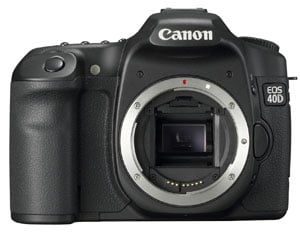 |
The EOS 40D is available as a body alone or in a number of different lens bundles depending on your geographic region. In Europe and Australasia you’re likely to have the choice of either the existing EF-S 17-85mm f/4-5.6 IS USM, or a brand new version of the EF-S 18-55mm f/3.5-5.6 kit lens now with IS, albeit not a USM focusing motor (pictured).
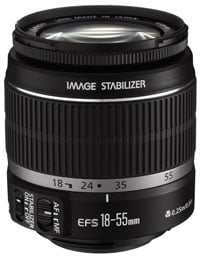 |
 |
Curiously, Canon America has opted to bundle the EF 28-135mm f/3.5-5.6 IS USM lens, which may have a longer reach than the other bundles, but with an equivalent focal length of 45mm when zoomed-out, is somewhat lacking in the wide angle department. At least Canon is pricing the lens bundle at only $200 USD more than the body alone though, so it’s a great value option.
One thing all three lens bundles have in common though is Image Stabilisation. Clearly the built-in anti-shake facilities on rival DSLRs from Sony, Pentax and Olympus have proven to Canon it needs to provide stabilisation in its standard bundles – and about time too. We’ll publish a full review of the new EF-S 18-55mm IS lens in the future, but in the meantime you may be interested in our Canon kit lens group test which compares the quality and features between several popular options.
Canon EOS 40D
auto-focusing
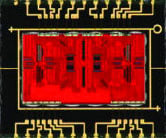 |
The Canon EOS 40D employs a 9-point AF system arranged in a diamond pattern, which at first glance appears to be the same as its predecessor. Canon has however upgraded the AF system so each of the 9-points are now cross-types, sensitive to both horizontal and vertical lines when used with lenses of f5.6 or brighter. The central point is also twice as sensitive as the others when used with a lens aperture of f2.8 or brighter.
Like its predecessor, the active focusing points illuminate as red boxes in the viewfinder, although if you find this distracting the lighting can be disabled in a custom menu. You can also use the thumb wheel or joystick on the back of the camera to manually select a focusing point if desired.
Like all Canon DSLRs there’s three auto-focusing modes: One Shot AF for still subjects, AI Servo AF for moving subjects, and AI Focus AF which automatically switches from One Shot to Servo when it detects a subject starting to move.
Fit the EOS 40D with a decent USM lens and its focusing speed is both quick and accurate. The focus calculation speed is actually 1.3 times faster than the 30D and Canon claims its predictive AF can track a subject approaching at 50kph. We put that to the test by fitting a Canon 70-300mm DO IS USM to the 40D, zooming it into 300mm and pointing the camera directly at on-coming traffic travelling at that speed. The 40D’s AI Servo Mode easily tracked the vehicles, which coupled with the high speed continuous shooting capabilities makes it a doddle to capture fast moving action.
The 40D does however still use the popup flash as an AF assist in dim light conditions, but if (like many) you find this flickering effect slightly alarming, you can disable it in a menu. For AF and MF details in Live View mode, see the next page.
Canon EOS 40D metering and exposures
The Canon EOS 40D offers the same four metering modes as its predecessor: 35-zone Evaluative, Partial (9% of v/f area), Spot (3.8% of v/f area) and Center-weighted. We used Evaluative metering for all our sample images and found very few occasions when we’d want to apply any compensation.
The EOS 40D offers shutter speeds from 1/8000 to 30 seconds plus a Bulb option; the shutter block is rated for 100,000 cycles and the fastest flash sync speed 1/250. The 40D also employs a new two-motor system for independently charging the mirror and shutter. This results in less vibration, quieter operation and a fairly unique sound when you take a photo – check out our Canon EOS 40D video tour to hear it for yourself.
Canon EOS 40D viewfinder
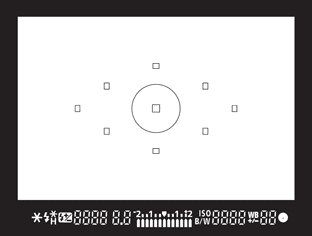 |
The Canon EOS 40D features a penta-prism optical viewfinder system which offers the same 95% field of view as the EOS 30D, but a greater 0.95x magnification to the 0.9x of its predecessor. This makes it noticeably bigger than the EOS 30D in practice, although when compared side by side with the D80, we felt the Nikon had a slight edge in size. The Canon EOS 5D’s full-frame viewfinder remains biggest of all though.
Look through the 40D’s viewfinder and you’ll see the nine AF points arranged in a diamond pattern, with a row of information running beneath. You’ll also notice the characters below the screen look much bigger – and brighter – than those on most other DSLRs, so if you’ve ever had difficulty reading the numbers in a DSLR viewfinder, the 40D could be the model for you. And in a very welcome move which most of us have been requesting for ages, the 40D now shows the ISO value at all times in the viewfinder.
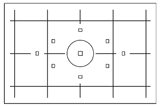 |
The EOS 40D also supports interchangeable focusing screens: along with the standard Ef-A Precision Matte, you have the choice of fitting the optional Ef-D Matte with grid or the Ef-S Super-Precision Matte for easier manual focusing with lenses sporting apertures faster than f2.8. It’s a shame Canon’s not implemented the LCD on-demand grid lines seen on all but the cheapest Nikon DSLRs, but at least there’s the option to swap focusing screens if desired.
Ultimately while the D80’s viewfinder appears slightly larger and has the benefit of on-demand grid lines, the EOS 40D’s viewfinder is still very, very good and a noticeable improvement over its predecessor. It’s without a doubt one of the operational highlights of using the EOS 40D.




